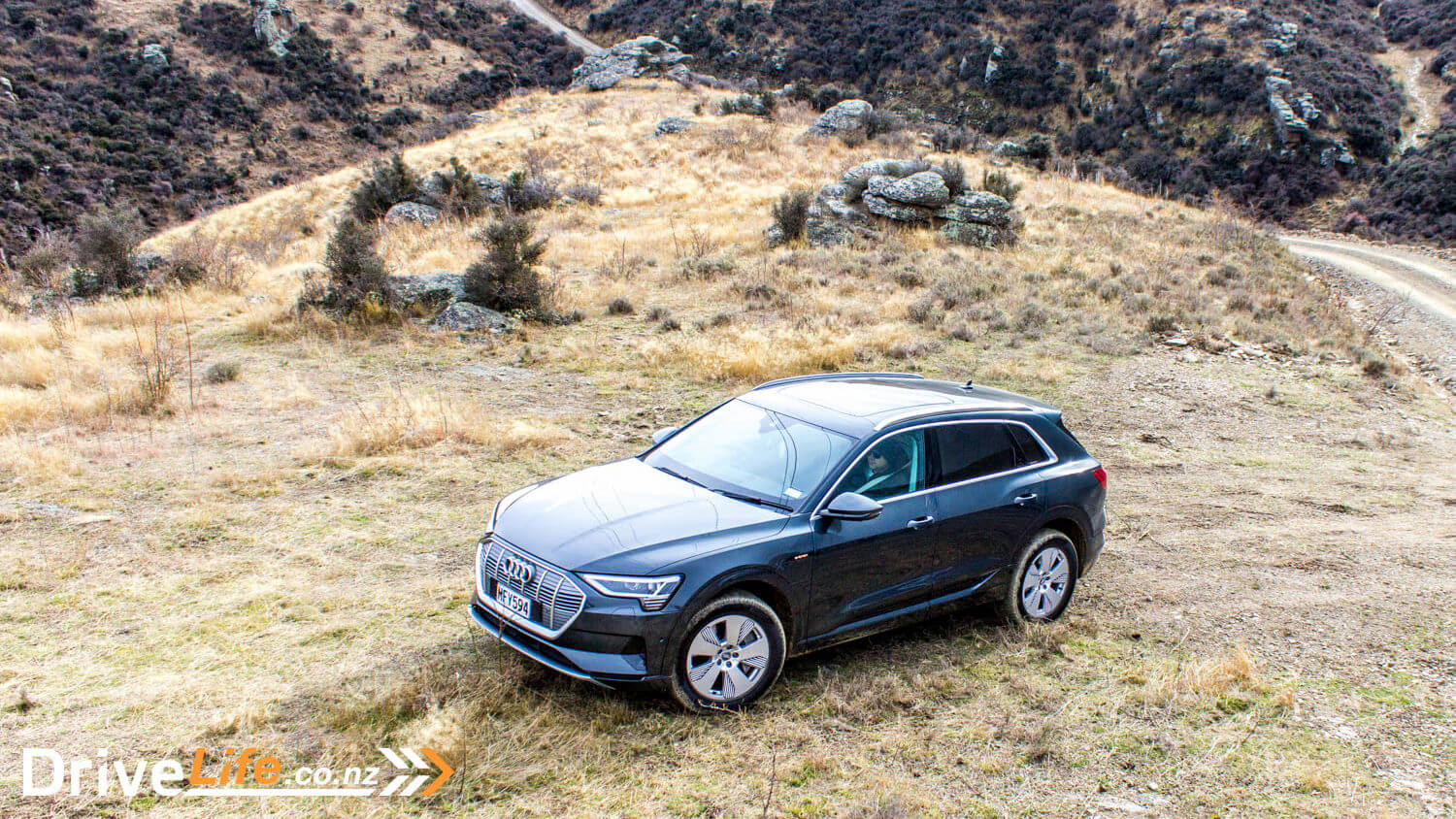“Electric has gone Audi”, we are proudly told. The most important Audi to be launched this year, DriveLife was invited to Queenstown to see the car in its natural habitat, and take it on some of the South Island’s excellent roads.
In May, we attended the release of the car, and came away impressed. An electric SUV with an actual towing capacity and good looks? Bring it on.
But I could only take the pre-launch cars for a 20-minute drive, as they were left-hand drive. Now, as promised, the first shipment of right-hand drive e-trons have arrived.
Should Jaguar, with its I-PACE, be worried? Should Mercedes-Benz with its yet to launch EQC be worried? All the signs say yes, but as always, we need more time behind the wheel and more details to make a real decision.
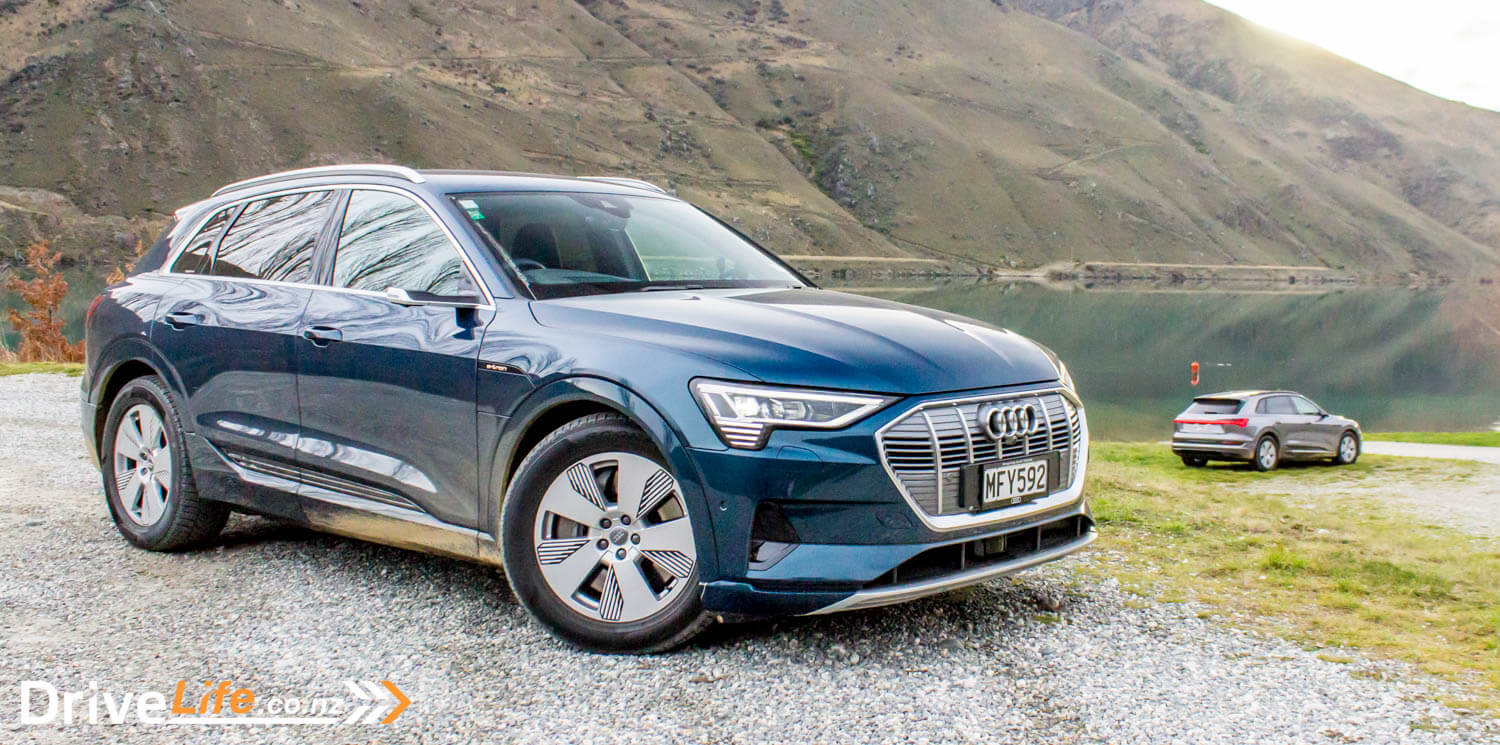
TECH TALK
First up, we heard from Dr Brendan Koehler. He is the Audi Product Manager e-Solutions, and was brought in from Germany especially for this launch. He discussed urbanisation and sustainability as main focus for Audi at the moment, and covered off topics like Shared Mobility, autonomous driving, Vertical Mobility, and a Robo Taxi (yes, you read that right).
Audi is also in cooperation with Airbus and Italdesign as part of Urban Mobility – for example, to develop an air shuttle for two people to travel across a city.
He covered off the future Audi models, including the now launched e-tron (a BEV, or Battery Electric Vehicle), FCEV (Fuel Cell Electric Vehicles) that will use hydrogen to recharge on-board batteries.
On the BEV front, there’s much desire to see the e-tron GT coupe that is to launched next year. It looks stunning.
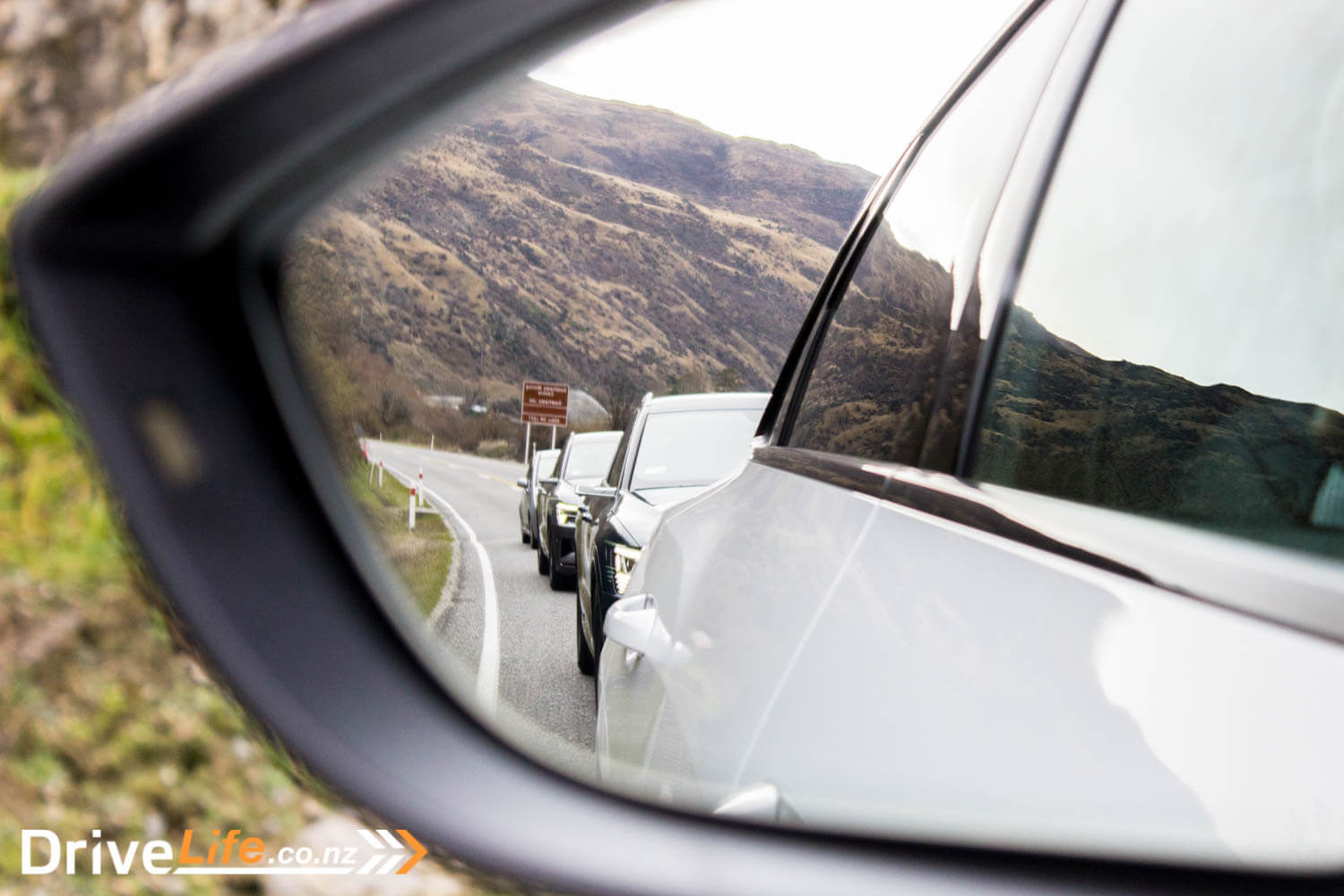
By 2025, Audi will have ten fully electric models he says, and by that same year, a third of Audi cars will be electrified. Interestingly, they are also looking at the g-tron – a car that runs on Compressed Natural Gas (CNG), a fuel that New Zealand used in the 1980s.
The h-tron – a fuel-cell vehicle using hydrogen to recharge batteries, will be in production by 2025 he said. That’s not too far away.
“For the e-tron, our predominant focus will be on charging, creating attractive BEVs, getting Charge Point Operators to invest in charging facilities, the Government on reducing barriers, and then lastly consumer awareness over options,” said Brendan. “e-tron is the first step to our electric future. The e-tron drives like normal car – you just get in and drive it.”
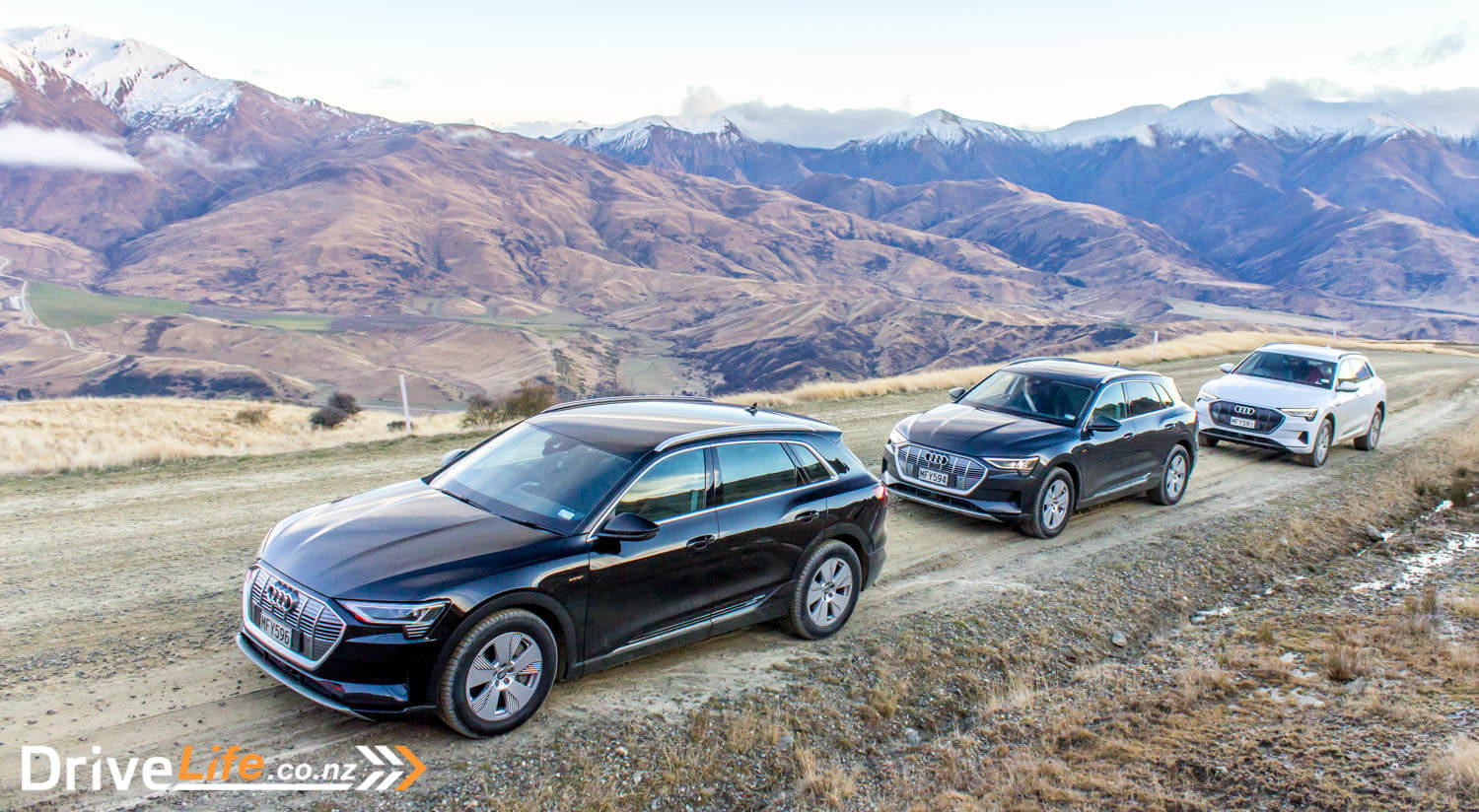
Due to a number of factors, New Zealand is the first country in the Asia Pacific region to get the e-tron. We’re the first market outside of Europe and USA, before China and rest of world.
On the New Zealand side of the market, sales of Plug in Hybrid Vehicles (PHEV) and BEV were shown. In 2015 new BEV and PHEV sales accounted for just 0.30% of the new car market. In 2019, this is expected to reach 2.2%. Still tiny, but growing steadily.
Still in 2015, there were 10 new PHEV & BEV models available. In 2019, this number is 36.
The allocation of 100 e-tron to the New Zealand market were pre-sold in 8 days, which was the whole of this year’s allocation.
That’s not to say Audi New Zealand has leapt into this. They’ve spent 5 years investigating the market, and solutions to go with the market. These solutions include looking at charging at home, or on the road.
Audi New Zealand has partnered with Vector and HRV, to develop home and business charging and energy management solutions for e-tron owners.
For those on the road, Audi have also partnered with ChargeNet, who have over 155 charging stations dotted throughout the country. E-tron buyers will receive a radio frequency ID tag (RFID tag) that can be used at ChargeNet charging stations to kick the process off.
As well as this, the built-in Satnav in every e-tron will display charging points around the country – those are all charging points (not just ChargeNet ones), and is complete with live updates so the list is always up to date.
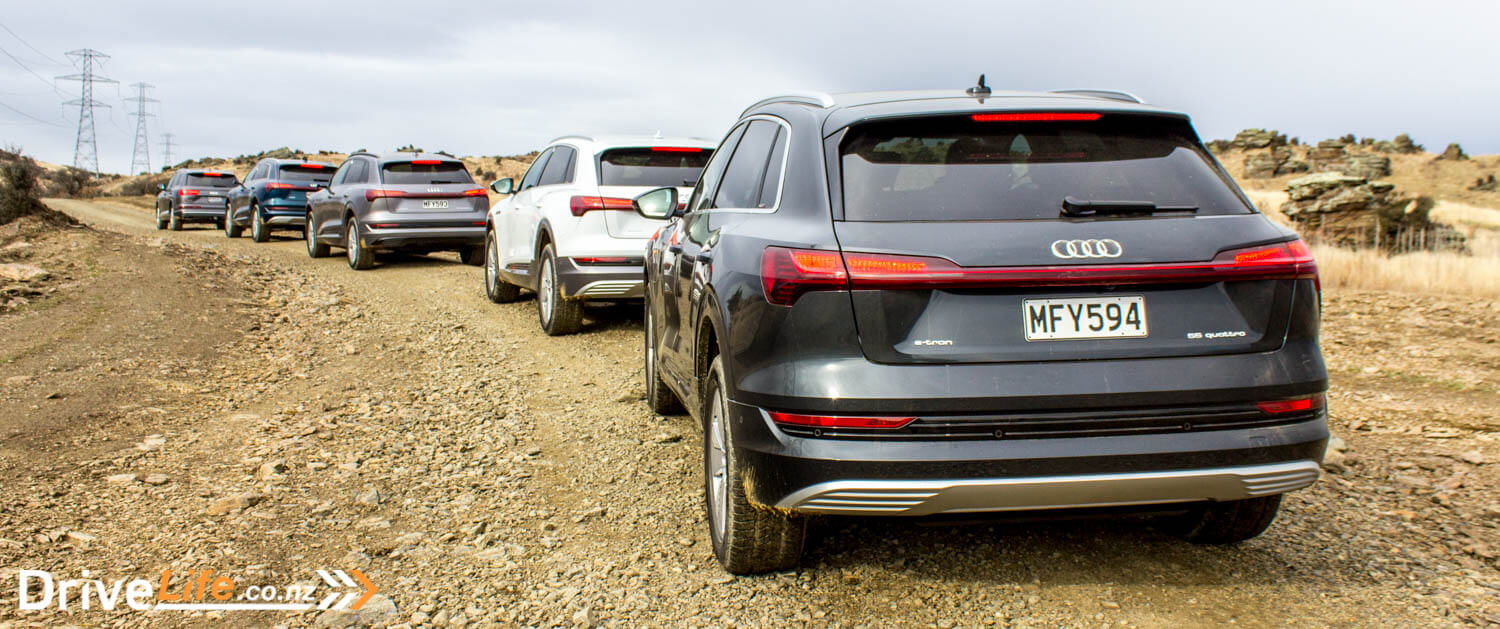
E-TRON
Jarrod Ho, Sales Operations Manager for Audi New Zealand, gave us the full run down on the e-tron.
This is Audi’s first BEV, and for that there’s a whole new plant in Belgium for the car, and it’s the only car produced in that plan. Every e-tron comes with a 5 year, 150,000km warranty, and a 3 year motoring plan. There’s also an 8-year/160,000km battery warranty.
They’ve tried to keep the car as ‘normal’ as possible, and this includes 660 litres of boot space with the second row up, and around 400km of range. There’s even a front grille, with a normal radiator behind it to assist in cooling the batteries when required.
Size-wise, the e-tron sits between Q5 and Q7/Q8. It’s slightly narrower than a Q7, and 30mm lower than a Q5 – but it’s still a full-size SUV.
On the outside, there’s blistered arches to give it a bit of an early quattro look, and “Stylised side sills”, showing where the batteries are on the car. A nice feature are the LED taillight across the rear of car, and these look brilliant at night.
The e-tron’s cD is about 0.7 less than a normal SUV, to give around 35km range extra. To achieve this via weight reductions would be losing 500kg, Jarrod tells us.
There’s been a lot of importance placed into aerodynamics development, including things like dimples over the plate that covers the batteries under the car, the rear suspension is covered, there’s a lower rear spoiler under the car, rear axle covers, sill covers, front axle covers, and a splitter for directing air around the front wheels.

VIRTUAL EXTERIOR MIRRORS
Lots of people are interested in the Virtual Mirrors. As an option, these are around $6,000, and are used mainly to reduce aerodynamic drag, and also to reduce blind spots. They don’t stick out far past body of vehicle – far less than a normal mirror – and this reduces the chance of collision to the mirror.
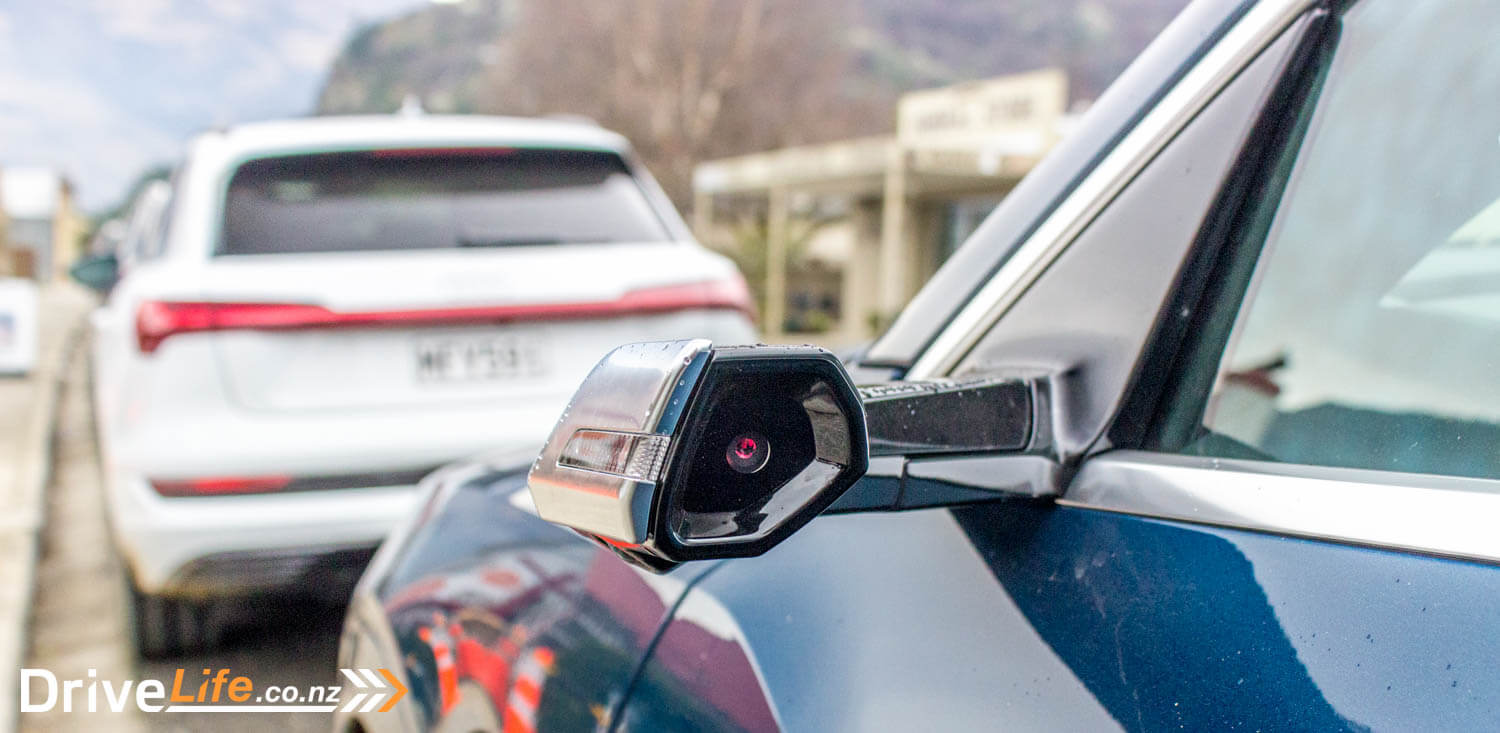
They also reduce the drag coefficient (cD) of the car – the standard mirrors have a cD of 0.28, while the Virtual Mirrors drop this to 0.27, to get an 5km extra range in normal driving conditions.
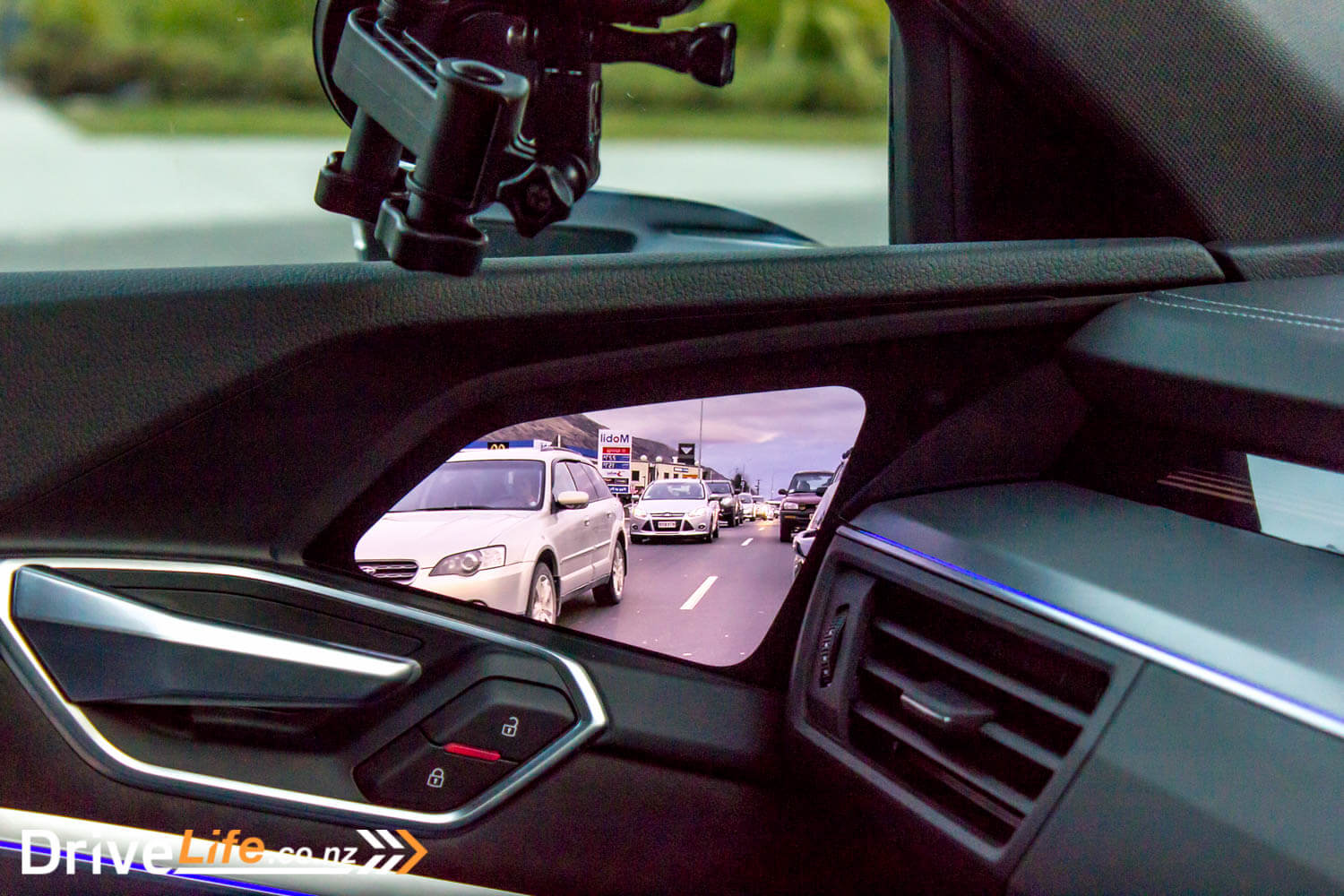
Reduced wind noise is another benefit, and there are 3 modes for the mirrors; highway driving, turning, and parking. These modes are selected automatically. The picture on the screens is excellent, and even in low light, the screens are enhanced to show a clearer picture. If water gets on to the camera lens, digital processing will remove the drops automatically. You can also pinch and zoom on the drivers screen, which controls both “mirrors”.
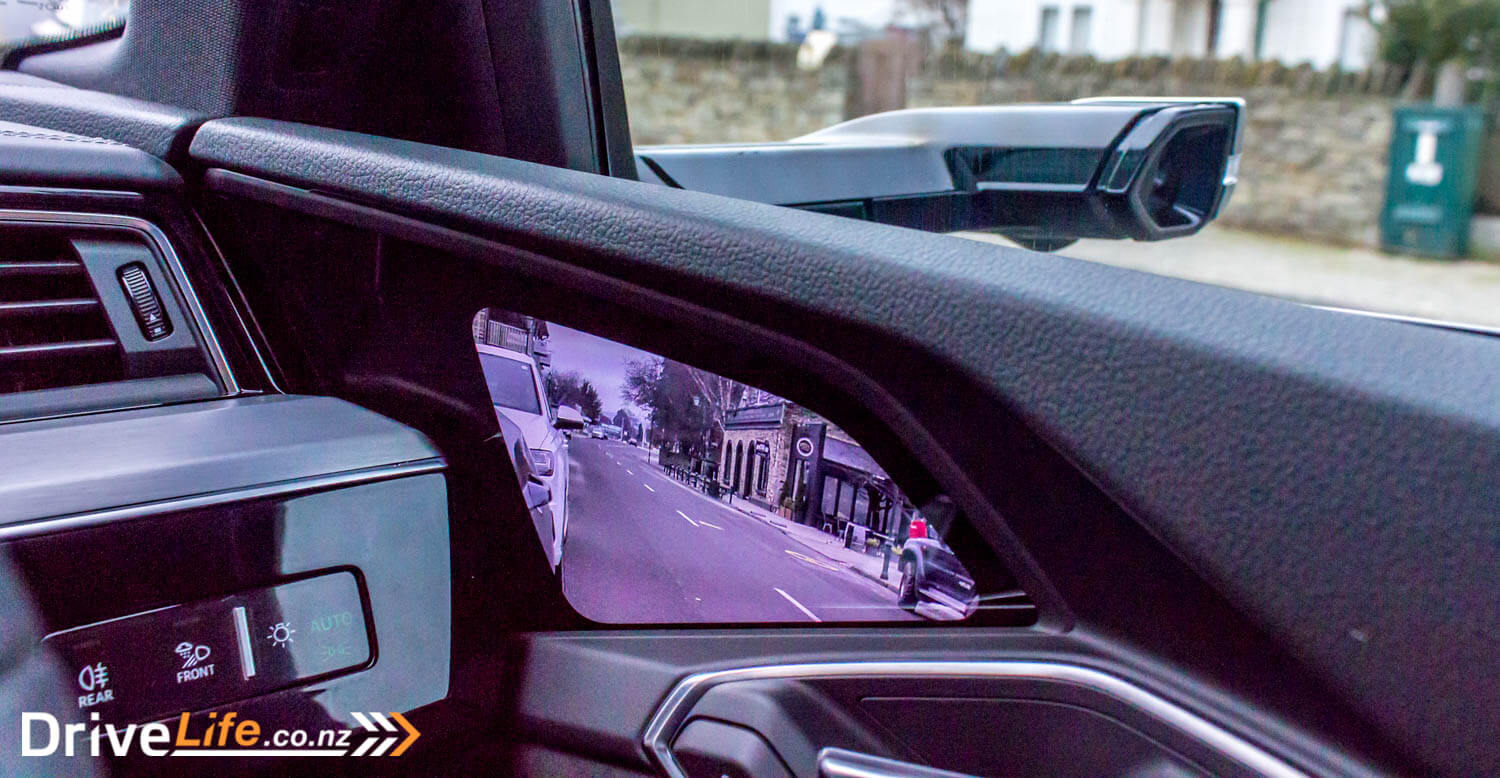
INTERIOR
The e-tron has the Q8’s dual screens, and in the place of a transmission shifter is a hand rest with the ‘Power Lever’, to control forward, reverse etc.
As far as power goes, there’s twin electric motors for true AWD. The result of these two motors means 300kW of power in total, and 664Nm of torque (in Sport mode.) If you drive the car in anything but Sport model, you have 561Nm of torque available.
The capacity of the batteries is 95kW, with a usable capacity of 84kWh to enable longer battery life. Performance is good for such a heavy car, with 100km/h coming up in 6.6 seconds, or 5.7 seconds in Sport mode. The electronics of the car are processing data while driving 10,000 times per second to adjust all driving parameters, which is 50 times quicker than a mechanical quattro system.
The e-tron is predominantly rear-wheel drive for efficiency purposes, switching to AWD as needed.
BATTERY
The battery pack is made up from 36 individual cells, each weighing 11kg to make for 700kg of battery weight. This is all positioned down as low as possible, under the floor pan.
A lot of emphasis has been placed on battery temperatures, with a Battery Thermal Management System in place. This is via thermally conductive gel to disperse heat, along with indirect cooling system via fluid which can be cooled by a traditional radiator in the front of the car. There’s also a separate chilling unit that can be used when necessary. This battery thermal management system is on 24/7, even if the car is just sitting there. You’d think this would be a big battery drain, but later Brendan tells me it’s only about 3% of battery capacity per month.
That 84kW (usable) battery capacity should be good for around 400km, according to Audi, using the WLTP system of measurement. The battery can be diagnosed and repaired, and if one cell goes faulty, a single cell can be replaced.
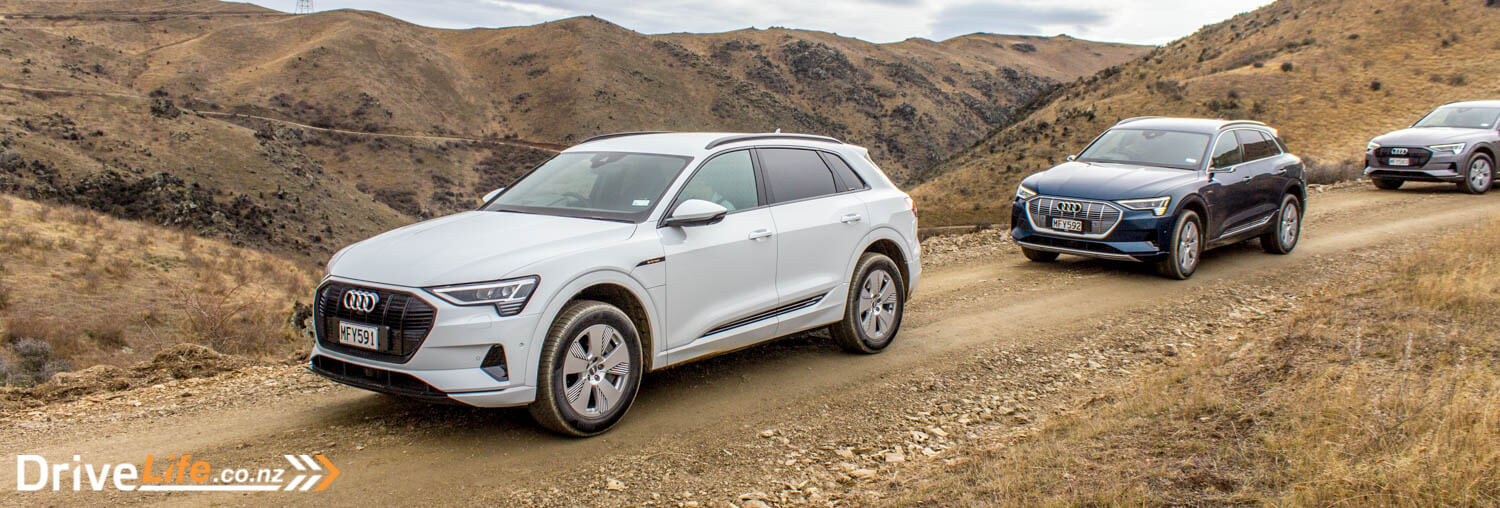
BRAKE BY WIRE
The e-tron is also the first EV of all with full by-wire braking system. Apparently this shortens stopping distances by 20% over conventional braking systems, while delivering a normal brake feel. During our two days with the car, we certainly couldn’t pick that everything was controlled by wire, rather than hydraulics.
The brakes themselves have had a lot of development too, and can build up brake pressure twice as fast as normal braking systems. This means that the brake pads sit out from discs a bit more than normal, to reduce drag. It may be a small amount of drag saved, but it all adds up.
CHARGING
The charging plug is a Type 2 CCS, that can do 11kW AC charging, or 150kW DC. Audi suggests charging at home is expected to meet 85% of the need.
Within the charging menu, you can program the GPS location of your home, tell the car what a charging target would be (e.g. 80% for longer battery life, or 100% for a long trip). You then define charging time slots to save money on your power, making the most of cheaper power in the early hours.
Or you can use the myAudi app to control charging, and can also analyse charging data, turn on heated seats etc.
TIME TO DRIVE
We grabbed a white base 55 quattro model to drive first (there’s just the two models), so no virtual mirrors just yet, and a few other niceties like electric steering wheel adjustment and a heads-up display missing. Heading south from Queenstown, the Audi drive team took us to the start of the Hawksburn “Road”, with an ominous sign at its beginning:
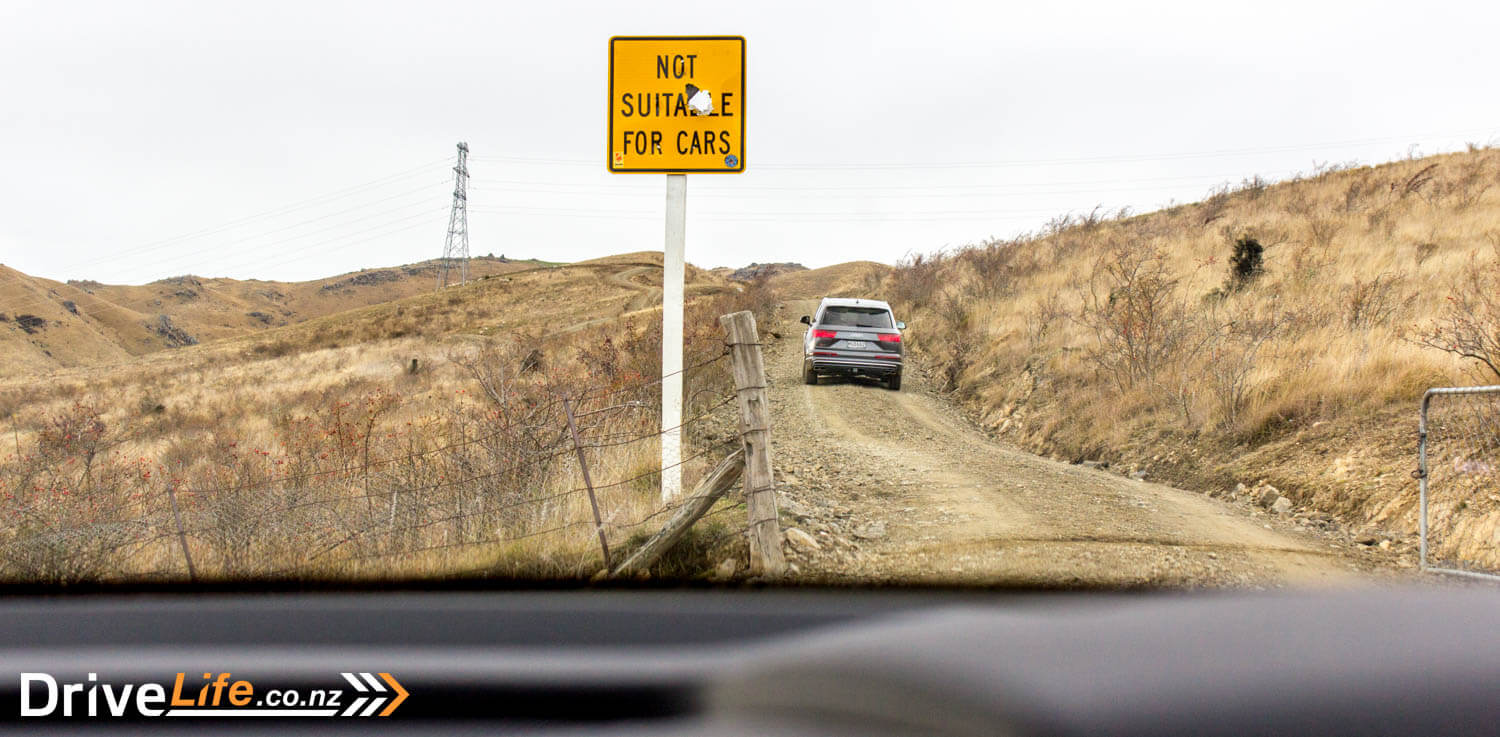
This was mainly a cycle track, but is also open to cars – but not recommended. All credit to Audi for taking us this way, rather than sticking to the tar seal. First things first, we selected the off-road mode, which raised the suspension up. As we descended down some pretty steep hills, I spotted the wet, slippery mud halfway down. 2.5 ton going downhill through mud? I needn’t have worried, as the e-tron cruised on through without any drama. Yes, we were running Pirelli Scorpion Winter tyres on the cars, but still – that’s a lot of weight to get down any muddy hill.
We switched spots, my turn to drive. We got to yet more muddy spots down hills, and I tried a bit harder to get the car to slide, but no go. I’m sure with road tyres it would have moved around more, but it was still bloody impressive for such a heavy car.
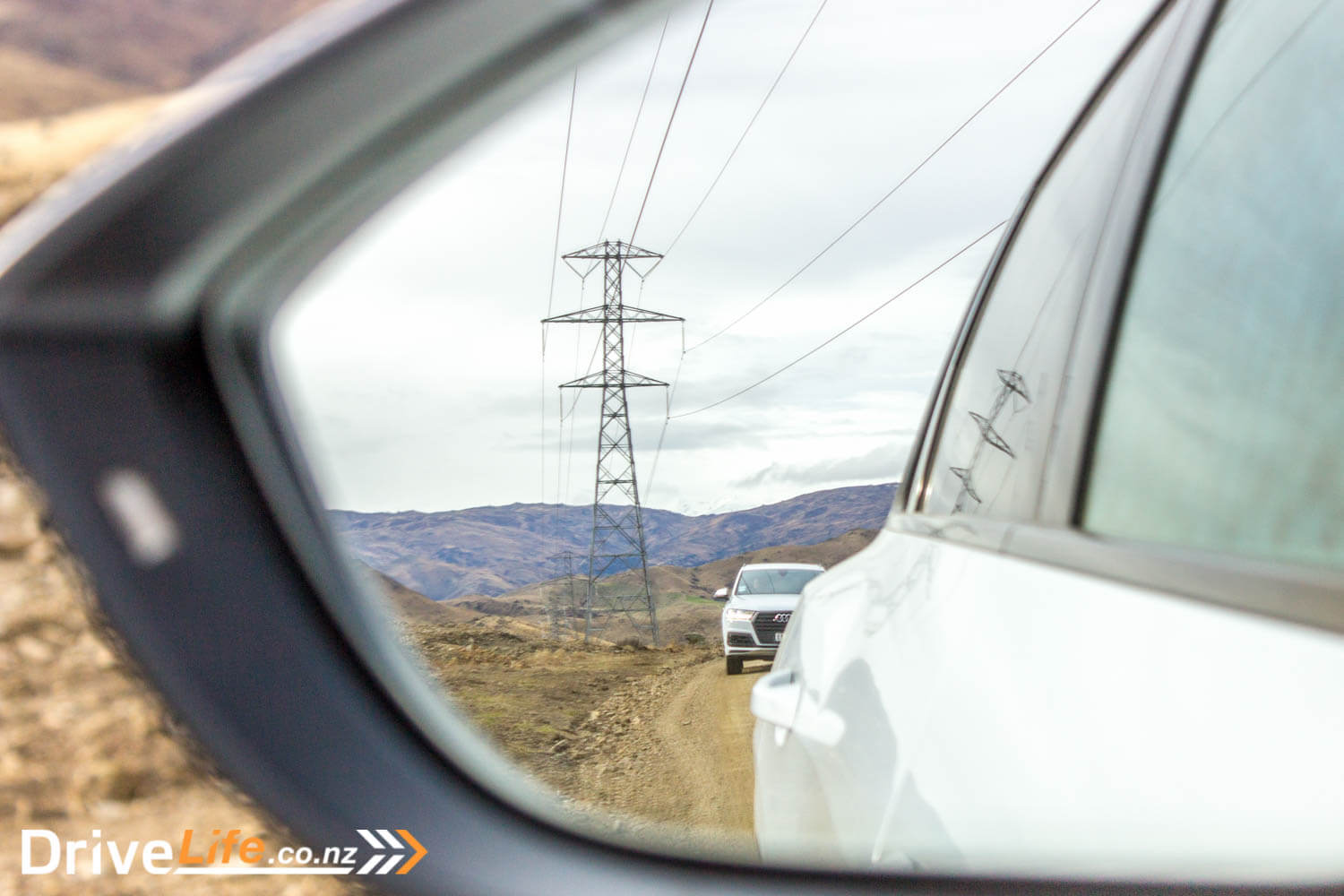
After 9 kilometres on this road, two things stood out: the electronic traction systems on the e-tron are excellent, and with that weight, it crushes bumps out – the ride is excellent on the bumpy stuff.
Back on the seal again, and time to check out the interior. The centre console is quite high, but is very deep since there’s no transmission. This means a decently-sized centre console cubby, and just generally more room to store your stuff. The e-tron comes standard with qi wireless phone charging, with a twist. Instead of being a flat surface, there’s a slot you put your phone in, so it sits vertically and this stops it sliding around.
The interior feels very much like a Q8, but with the power lever instead of a normal shifter. The entire ride is serene, as you’d expect, and the car simply floats along the road with little fuss. After two days behind the wheel, you get the feeling that it’s a very relaxing car to drive, and is never stressed, and this translates to the driver too.
Next stop for the convoy of electric SUVs was Clyde Dam, the second biggest in New Zealand. We got permission to drive across the top of the dam, which was pretty cool, and then drove down to the base of it, for a guided tour. If you are in the area, definitely check it out. As a special treat, Audi lined up the e-trons and the spillway opened up for a ‘spillover test’ at the same time.
It was a sight to see, and was a great way to highlight that 85% of all New Zealand’s power comes from renewable energy of some sort.
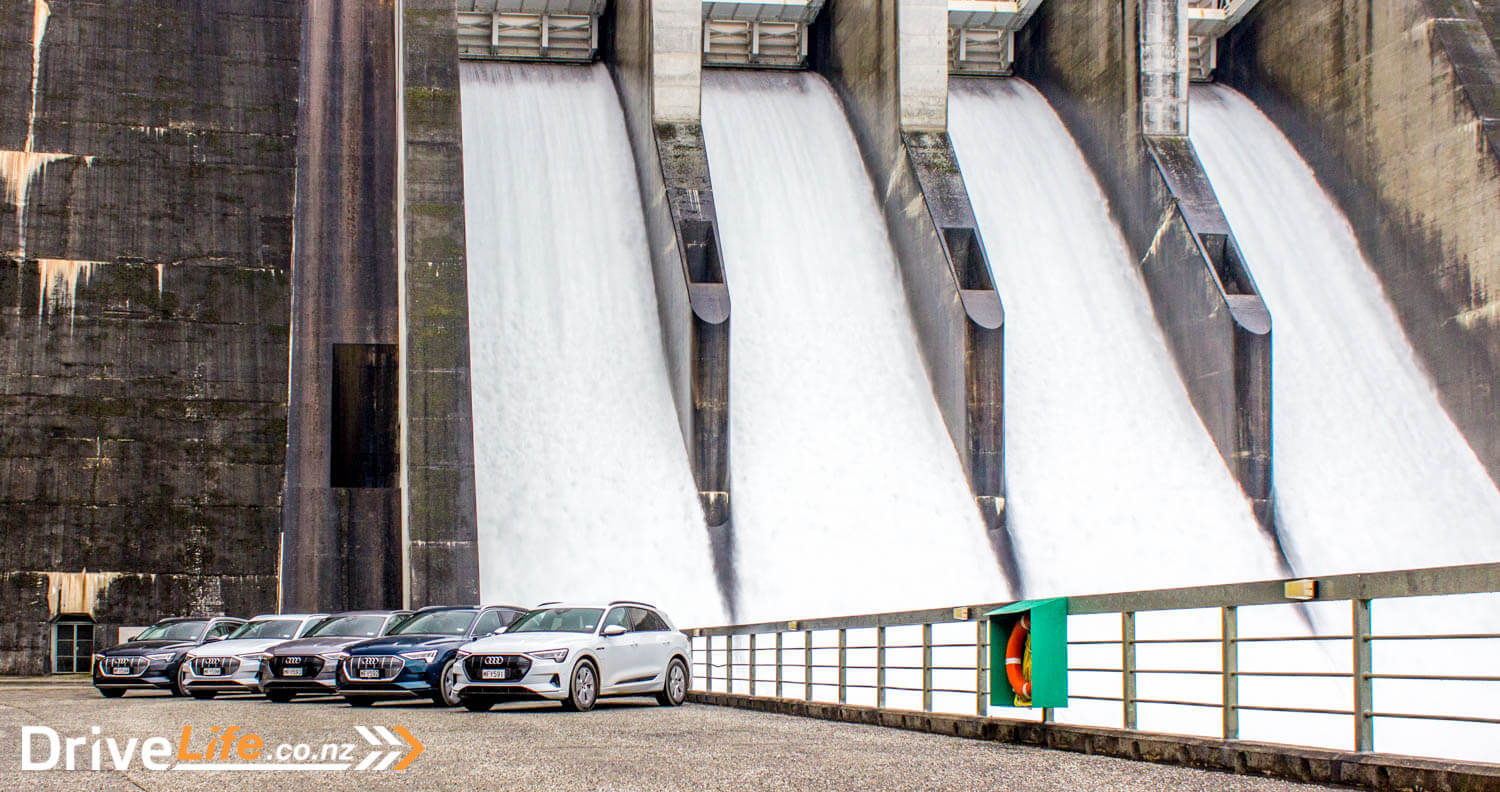
We stopped in the township of Clyde for lunch, and this gave me the chance to take a drive in one of the e-trons that had a trailer hooked up to it, complete with 1.6 tons of car parts inside. Since the e-tron is rated at 1.8 tons for towing, this was a good test, even if it was a short drive.
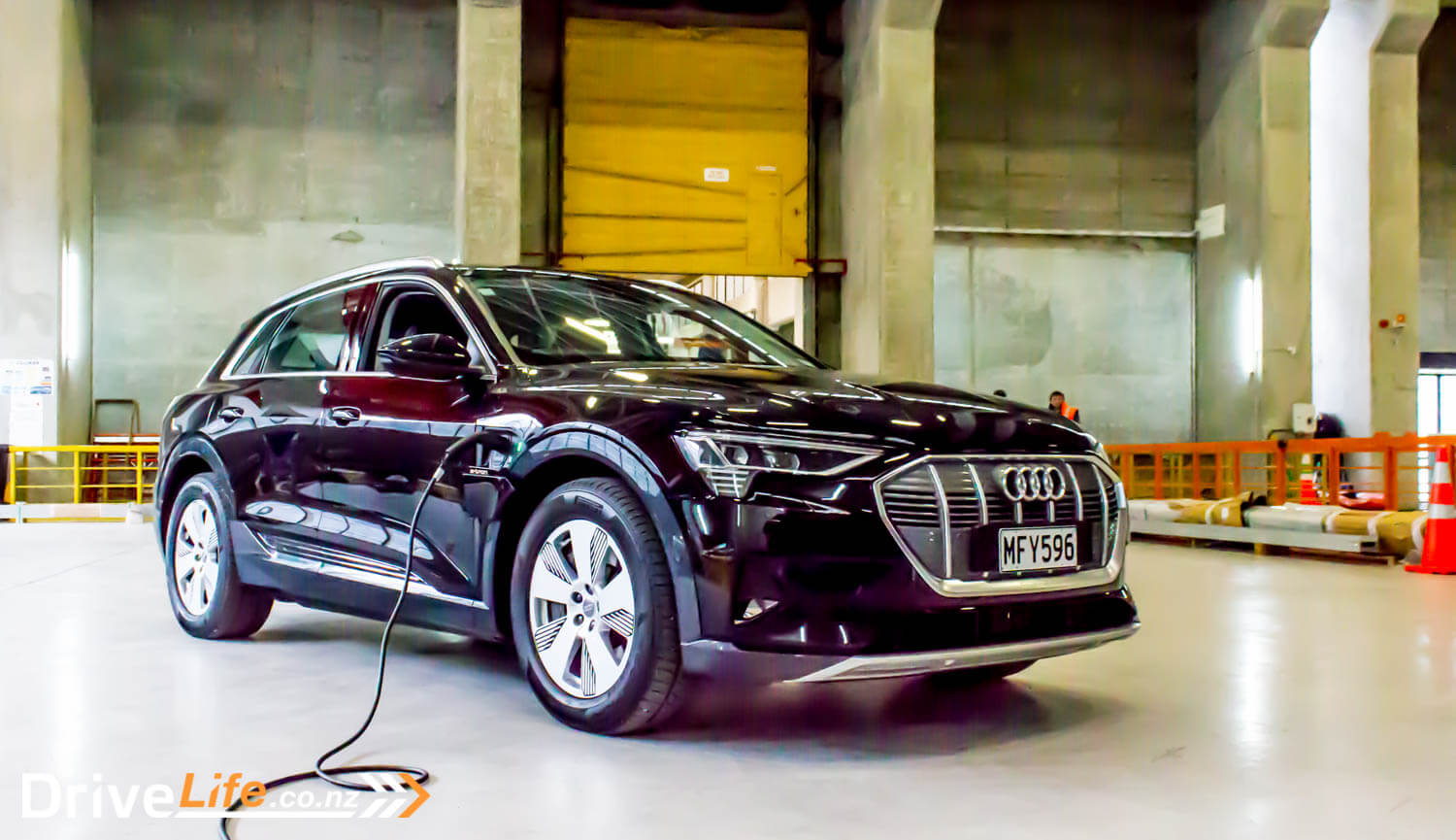
How did it go? Very well. Instant torque – and loads of it – make for great towing, and was a much smoother experience than a diesel engine. I barely noticed the trailer behind the car, as the suspension kept the car completely level. A new way to tow, but a nice way. Naturally, all that extra weight is going to use more energy to pull, and that means less range. Audi suggested around 200km if you are towing a trailer with max, or near to max towing weight.
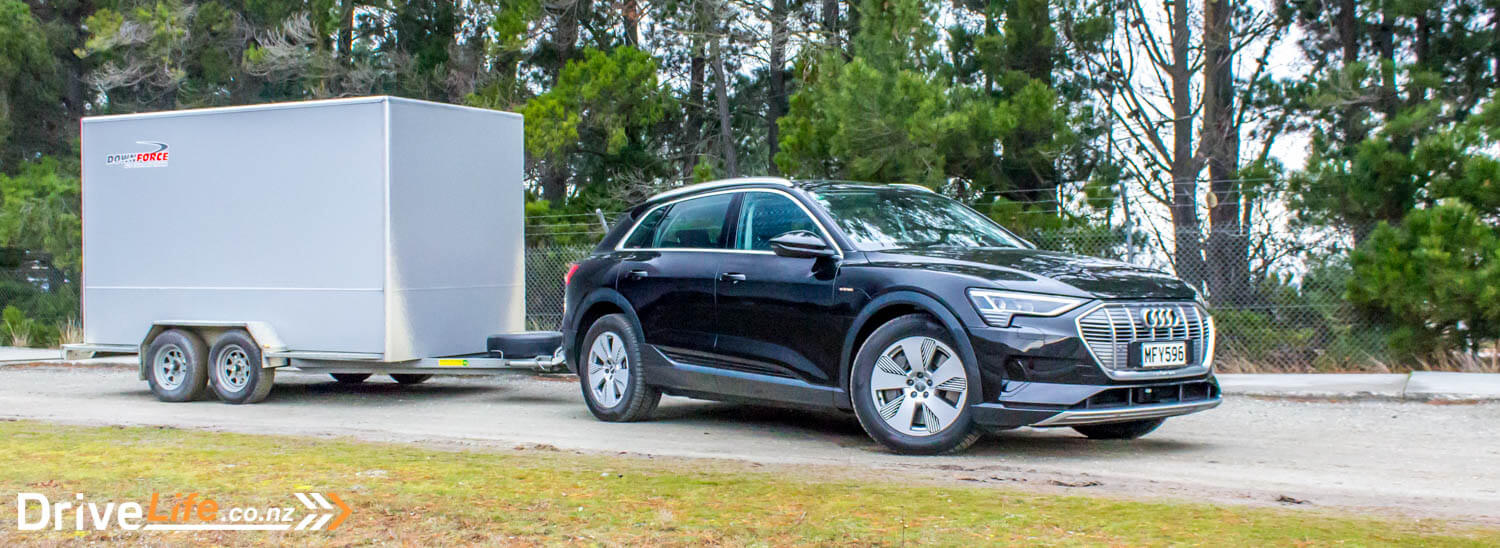
Lunch over, it was time for me to drive the car back to Queenstown. Those who know that road will know it’s pretty twisty, but the e-tron handled it beautifully, with all that weight of the batteries down low contributing to an almost flat stance on the corners. It really does handle well, and it’s easy to get the car to keep everything smooth and nicely lined up between the corners.
DAY TWO
The next morning, we were told we were heading to the Southern Hemisphere Proving Grounds, where we’d be taking the 2.5 ton cars onto the ice to see what they handle like in that situation. I for one, was a bit unsure about this. Even with electronic systems, 2.5 tons on ice? Sounded like a recipe for damaged panels.
As another world first, we would be the first ‘public’ drivers to take an EV to the Southern Hemisphere Proving Grounds. They’ve had others there for testing all camouflaged up, no doubt), but Audi decided this was the perfect time to grab another ‘first’ before someone else did.
So, still with the Pirelli Scorpion Winter tyres on, we hit the road to Cardrona, the car again so smooth and effortless. Five e-trons cruised up the hill to the proving grounds, and after a driver’s briefing, we headed out to the ice.
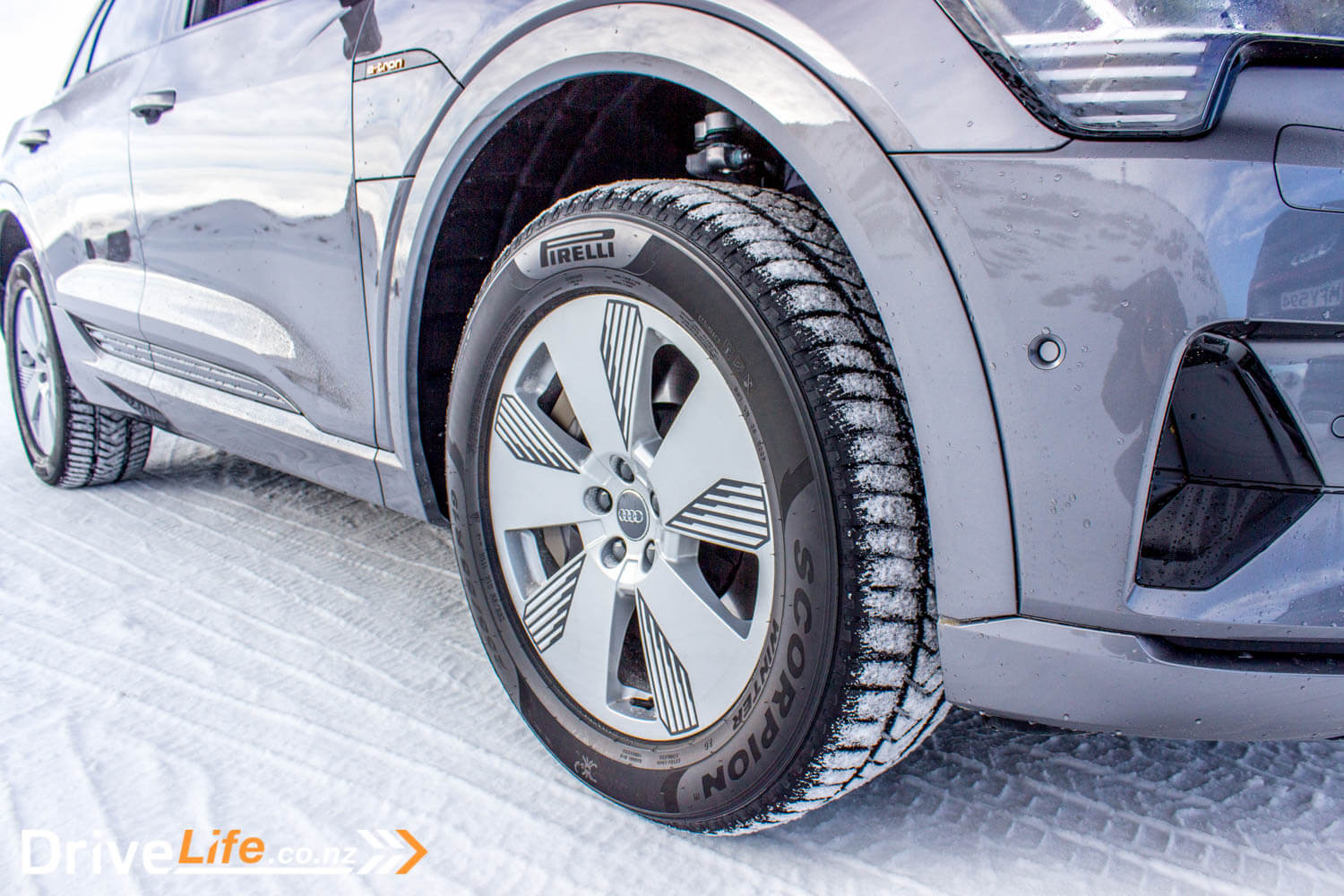
First up was a demonstration of getting the car to understeer. It’d be nice to know the electronic systems were keeping things in check, but we were instructed to turn off traction control, so we could get the car sideways easier. Sounded good to me!
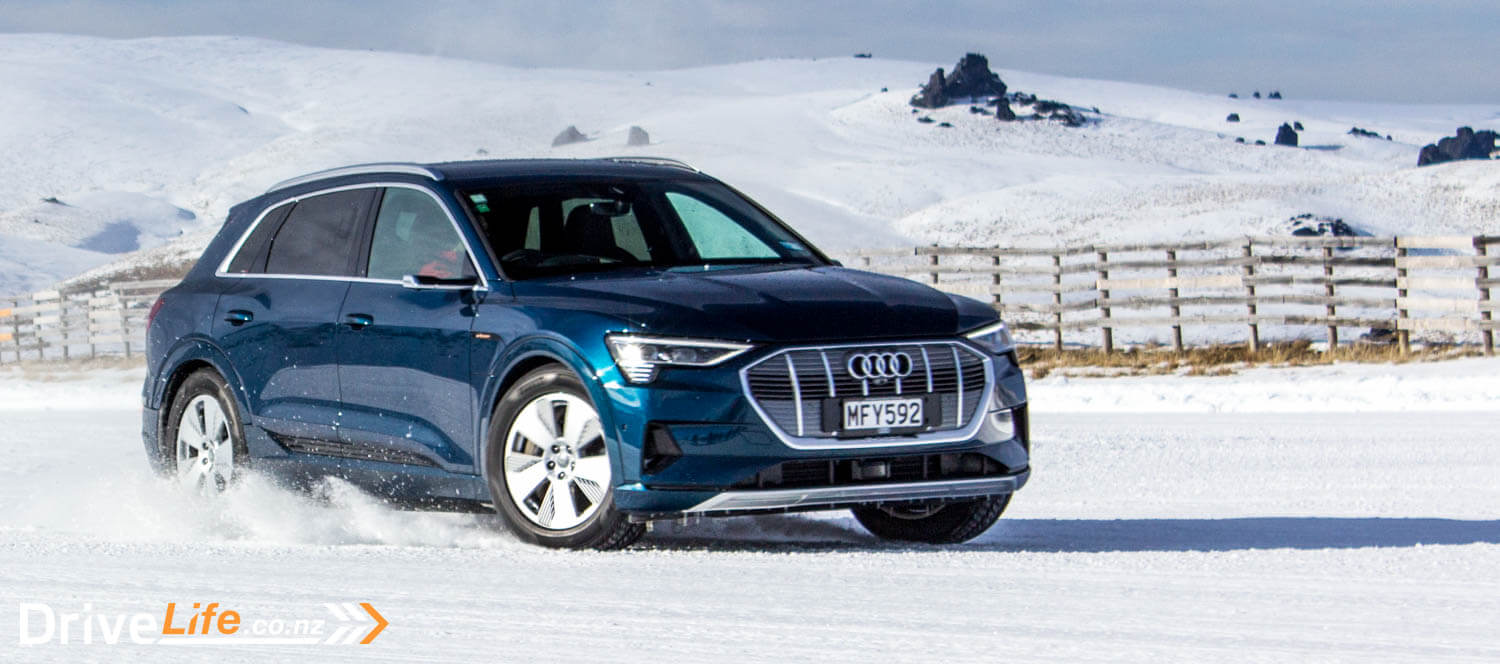
After everyone had two runs at the understeer part, we moved on to getting the cars to oversteer, by crawling, turning hard and flooring it, allowing the huge amount of torque to get the car sideways. This part, I liked. Another two runs at this, with all the e-trons performing well.
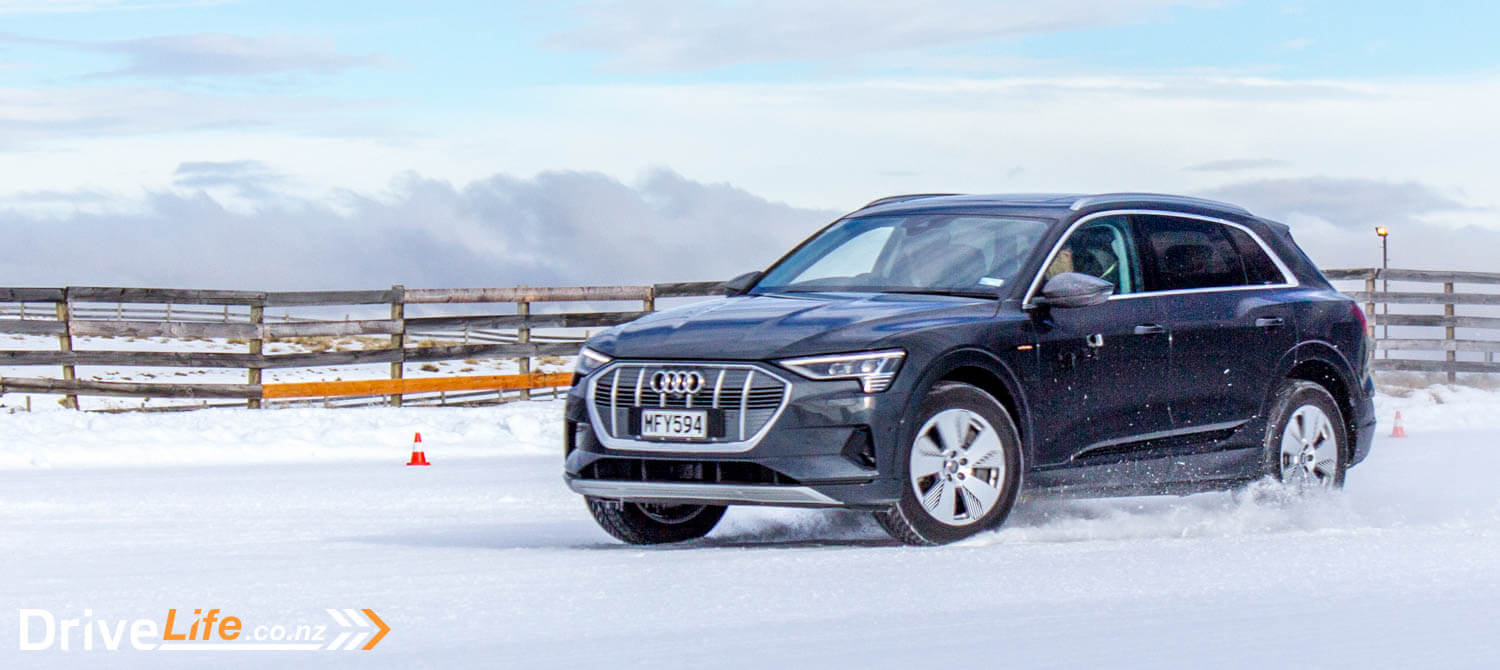
Event three was a slalom, again with traction control off. This was a lot of fun too, and it was interesting that even with all that torque and no traction control, you still had to nail the ‘gas’ pedal to get the car to go sideways – if you wanted it to. My fears about all that weight on ice disappeared on this part of the day.
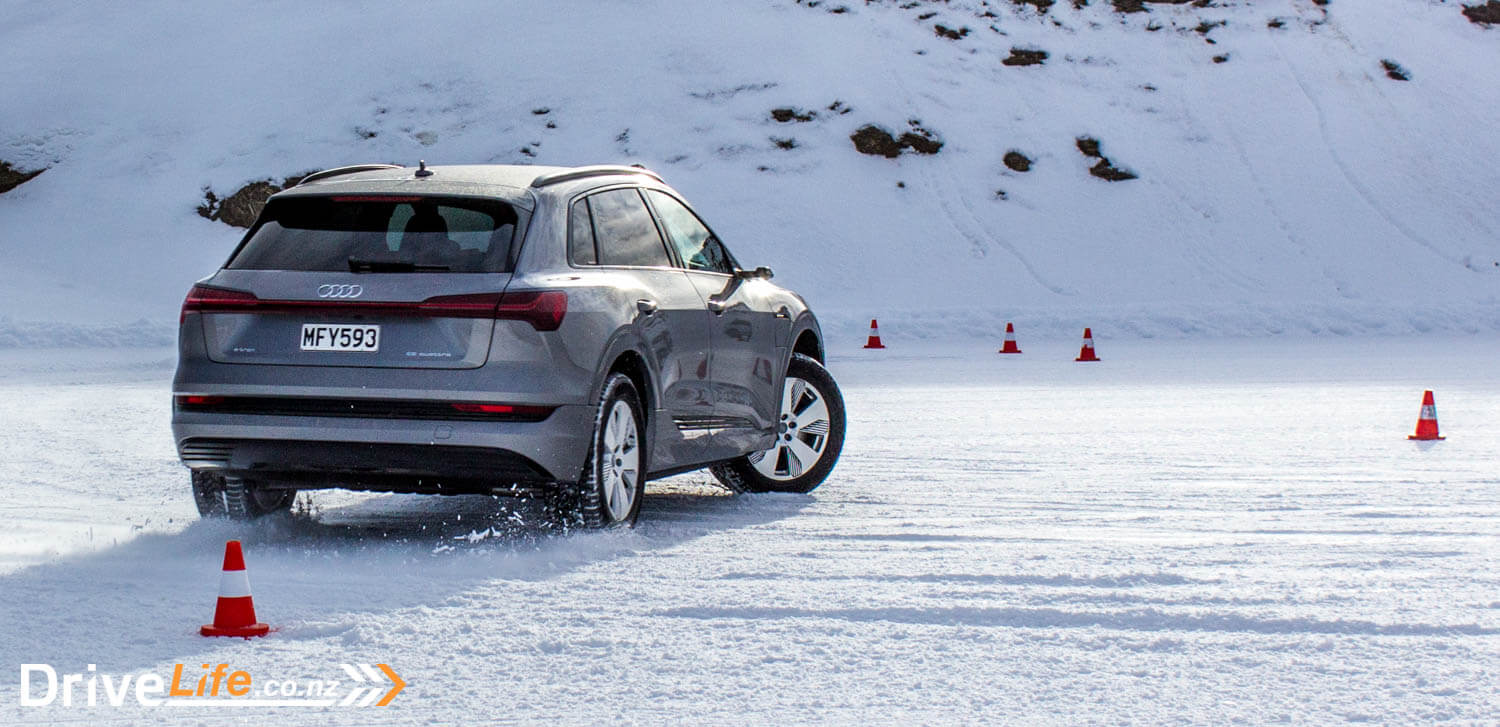
Our last event was a ‘dog bone’ run, like a figure of 8 but with no crossover. It took a lot of control with the accelerator and sometimes the brake pedal, but we all managed to get some nice control or the cars, except for the occasional spin out. Great fun, and a great way to learn about the capability of the car.
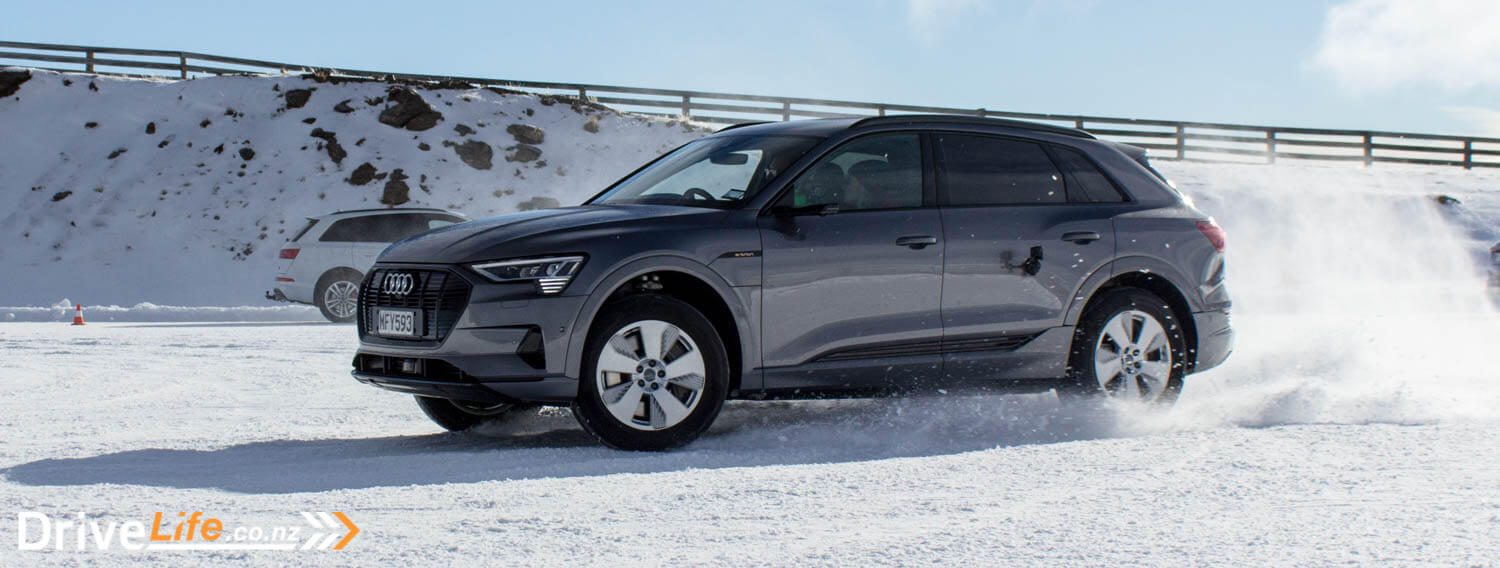
All too soon our time on the ice was over, but Audi New Zealand had one more thing planned. An ‘economy’ run back to Queenstown, with a prize going to the team who used the least amount of battery capacity to get to the airport.
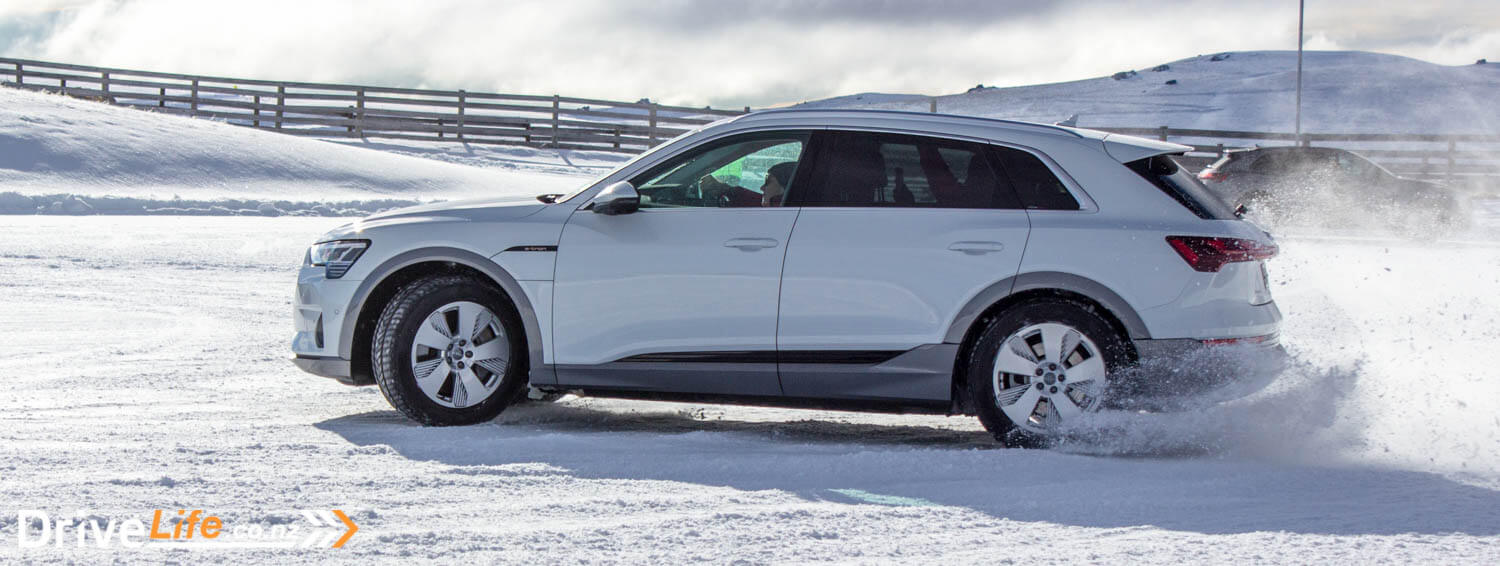
With our car sitting on 80% capacity and 201km of range, we set the Drive Control to Efficiency, turned off the AC and seat heaters, and lowered the suspension down as low as possible. With me driving, we hit the road to travel the 50km back to Queenstown from the proving grounds.
Using as much driving skill as possible, we husbanded our momentum where we could, and only once had to use over 25% of the available power, to get up to the top of the Crown Range. It wasn’t too hard, mainly a matter of using the recuperative braking where we could, as well as coasting as often as possible.
The end result was we used 6% of our battery capacity, and our range went from 201km to 231km. Not too bad! However, the surprise came when the results were read out – every car used 6% to do the return trip. So the result came down to the amount of power used in kWh/100km. Ours was set down at 16.5kWh/100km, so I thought we had a chance, but we were beaten by 0.2 by another team. It does go to show even with different driving styles, your power economy can be very similar.
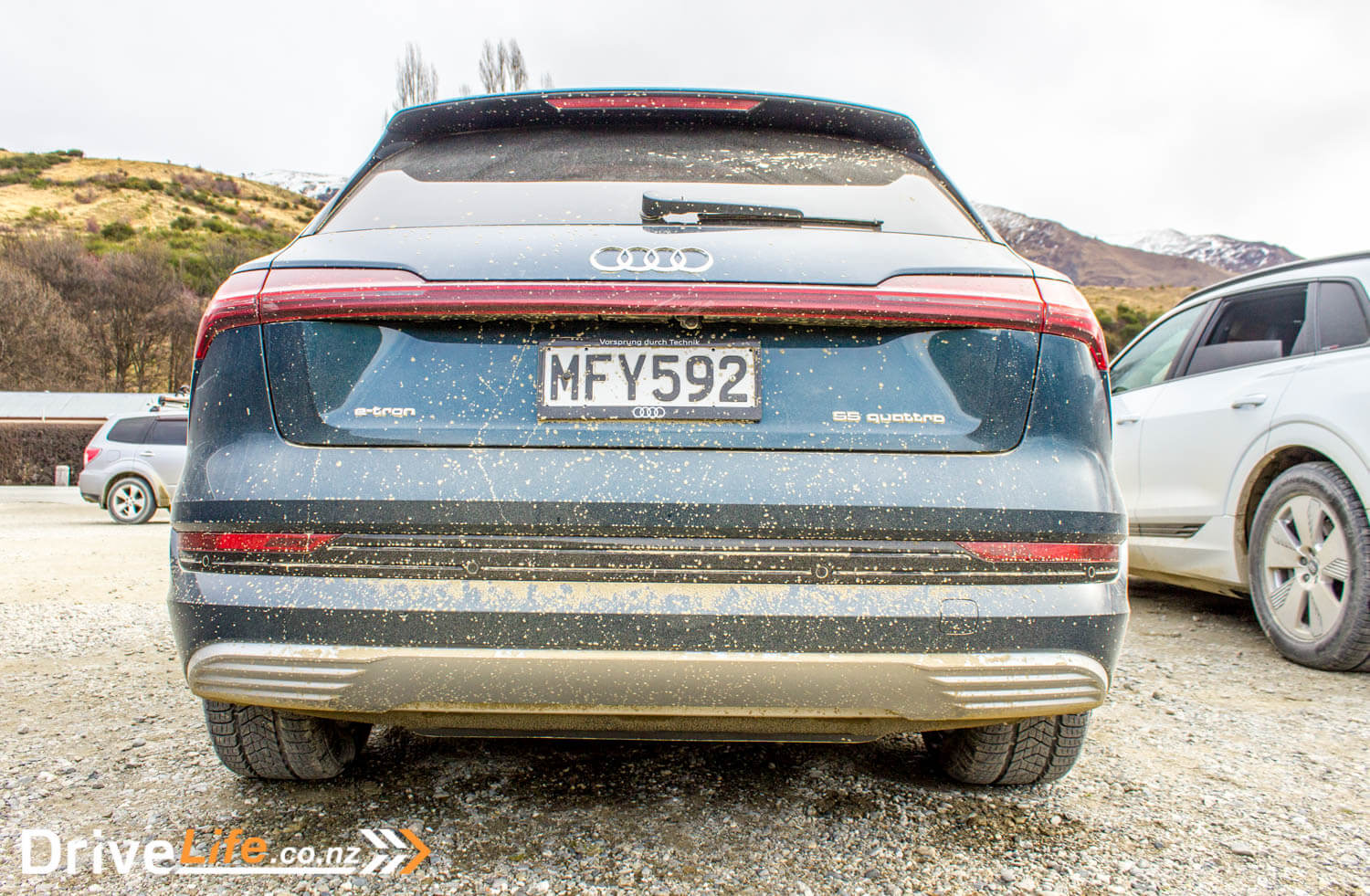
WHERE TO FROM HERE?
At the moment, Audi almost has this segment of the market to itself. There’s the Jaguar I-PACE, but it’s smaller and the towing capacity is not rated at all. There’s the new Mercedes-Benz EQC, but this isn’t available until around December, although it too has a tow rating of 1.8 ton. Some people might not care about towing capacity, but for others it’s all about how much it can tow – or even has a rating to be able to tow.
But the problem may be supply; the first shipment is all but sold out, and while orders are being taken, there’s still supply issues. This is a car that’s in demand, and for good reason, if the launch drive is anything to go by.
In September, we will be testing the car properly, and then can tell all. Stay tuned.
Audi e-tron
- 55 quattro, $148, 500
- advanced 55 quattro, $157,000


